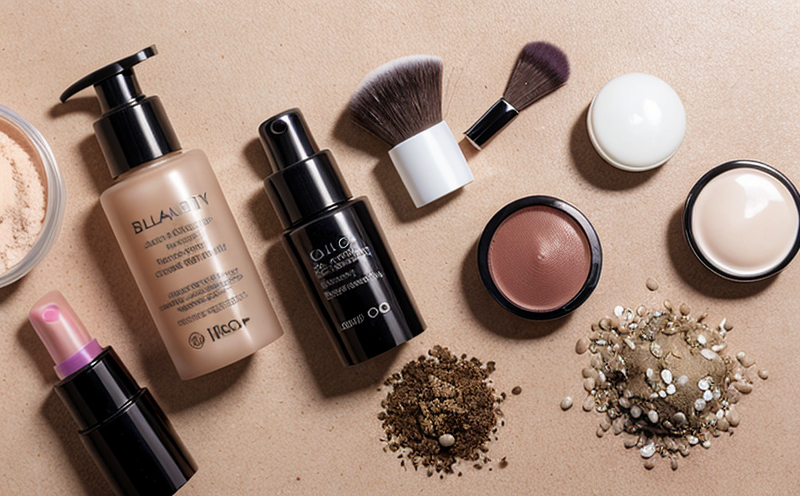Photodegradation Testing of Cosmetic UV Filters
The photodegradation testing of cosmetic UV filters is a critical component in ensuring the safety and efficacy of sun protection products. This process involves simulating real-world exposure to ultraviolet (UV) light, which can lead to degradation of organic compounds present in sunscreen formulations. By understanding how these UV filters behave under direct sunlight, manufacturers can optimize product performance and ensure regulatory compliance.
The primary objective of photodegradation testing is to evaluate the stability of UV filters over extended periods. This includes assessing whether the filter maintains its initial SPF value throughout the expected shelf life of the cosmetic product. Additionally, this type of testing helps identify potential degradation products that could pose risks to consumers or the environment.
One key aspect of photodegradation testing is exposure to different wavelengths of UV light, typically UVA and UVB radiation. These rays can cause chemical changes in certain ingredients used within sunscreen formulations, potentially reducing their effectiveness over time. Understanding these interactions allows formulators to select more stable ingredients or develop better stabilizers.
Another important factor during photodegradation testing is the use of appropriate test chambers equipped with artificial light sources that mimic natural sunlight conditions as closely as possible. These chambers often incorporate filters designed specifically for UVA and UVB simulation, allowing researchers to precisely control exposure parameters such as intensity, duration, and wavelength distribution.
Preparation steps prior to commencing photodegradation tests are crucial in ensuring accurate results. This generally involves preparing batches of sunscreen samples according to standard procedures outlined in relevant international standards like ISO 21368 or ASTM D7954. Samples must be stored under controlled conditions before and during testing to prevent any unintended degradation from occurring outside the test environment.
During actual testing, it is essential to monitor various physical properties of the UV filters including absorption spectra, molecular weight changes, and overall stability indices. Advanced analytical techniques such as spectroscopy or chromatography may be employed depending on the specific requirements set forth by clients or regulatory bodies.
The results obtained from photodegradation tests provide valuable insights into the longevity and reliability of UV filter systems used in sunscreen products. Based on these findings, manufacturers can make informed decisions regarding ingredient selection, formulation adjustments, and potential improvements to enhance product quality while meeting stringent safety standards.
Compliance with international regulations plays a significant role in ensuring that photodegradation testing meets industry expectations. For instance, both EU and US authorities require rigorous evaluation of active ingredients used in sunscreens, particularly focusing on their stability under simulated sunlight conditions. Adherence to recognized protocols ensures that test results are accepted globally, facilitating easier market entry for new products.
Understanding the environmental impact associated with cosmetic waste is another crucial consideration when evaluating UV filters through photodegradation testing. As society increasingly demands greener alternatives, it becomes necessary to assess not only human safety but also ecological sustainability aspects of ingredients used in sunscreens. This holistic approach ensures that innovative solutions addressing both consumer needs and planetary health are developed.
In conclusion, photodegradation testing serves as an indispensable tool for safeguarding public health while promoting responsible environmental practices within the cosmetic industry. By leveraging advanced methodologies and adhering to stringent standards, laboratories play a vital role in advancing knowledge around this important subject area.
Benefits
The benefits of photodegradation testing extend beyond mere compliance with regulations; they offer tangible advantages that contribute significantly towards enhancing product quality and safety. Firstly, by identifying potential stability issues early on during development stages, companies can refine formulations to achieve optimal protection levels against UV radiation without compromising long-term effectiveness.
Secondly, this type of testing helps reduce the risk of adverse reactions among end users who may be sensitive to certain chemical components found in sunscreen products. Through rigorous evaluation processes, potential allergens or irritants can be minimized, thereby improving overall consumer satisfaction and trust.
A third benefit lies in fostering innovation within the industry by encouraging research into more durable and sustainable alternatives for traditional UV filters. As public awareness grows regarding the environmental impacts of chemical sunscreens, there is increasing pressure to explore natural or synthetic substitutes that offer comparable performance but with lower ecological footprints.
Lastly, photodegradation testing contributes positively to brand reputation by demonstrating a commitment to excellence in product manufacturing and quality assurance practices. In today's competitive market, companies that prioritize sustainable development and consumer safety are more likely to gain favor among eco-conscious consumers seeking reliable sun protection solutions.
International Acceptance and Recognition
The importance of photodegradation testing in the cosmetic industry cannot be overstated, as it aligns closely with global regulatory requirements aimed at ensuring product safety and efficacy. In Europe, for example, Directive 76/769/EEC mandates that all sunscreens undergo rigorous evaluation regarding their ability to maintain effectiveness over specified periods when exposed to UV light.
Similarly, in the United States, the Food and Drug Administration (FDA) requires manufacturers to provide data demonstrating both stability and efficacy of active ingredients used in sunscreen formulations. These regulatory bodies emphasize the necessity for photodegradation testing to ensure that products meet stringent safety standards before being made available to consumers.
Besides compliance with legal mandates, international acceptance also hinges upon adherence to recognized standards such as ISO 21368 and ASTM D7954, which outline best practices for conducting photodegradation tests on cosmetic ingredients. By following these guidelines, laboratories can produce consistent results that are widely accepted across borders.
Recognition from reputable organizations adds further weight to the credibility of photodegradation testing methodologies employed in various regions worldwide. For instance, certification bodies like NSF International and Underwriters Laboratories (UL) often endorse tests conducted according to internationally recognized protocols, providing assurance to consumers about the quality and reliability of sun protection products.
In summary, photodegradation testing enjoys widespread acceptance and recognition within the cosmetic industry due largely to its alignment with regulatory requirements and adherence to established standards. This ensures that manufacturers adhere to high-quality benchmarks while also promoting consumer confidence in the safety and efficacy of their products.





